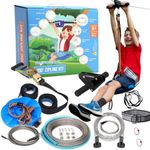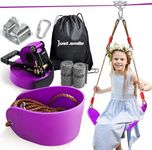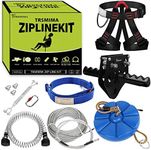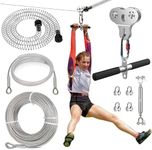Buying Guide for the Best Zip Line Kits
Choosing the right zip-line kit can be an exciting yet daunting task. Zip-line kits are a fantastic way to bring adventure to your backyard or any outdoor space. When selecting a zip-line kit, it's important to consider several key specifications to ensure safety, durability, and fun. Here’s a guide to help you navigate through the essential features and make an informed decision that best fits your needs.Length of the CableThe length of the cable determines how far you can travel on your zip-line. This is important because it needs to fit the space you have available. Zip-line cables come in various lengths, typically ranging from 50 to 200 feet. For smaller backyards, a shorter cable (50-100 feet) is usually sufficient. For larger areas or more thrilling rides, you might want a longer cable (100-200 feet). Measure the distance between the two points where you plan to install the zip-line to choose the appropriate length.
Weight CapacityWeight capacity indicates the maximum weight the zip-line can safely support. This is crucial for safety reasons. Zip-line kits generally have weight capacities ranging from 200 to 350 pounds. If the zip-line will be used by children, a lower weight capacity may be sufficient. However, if adults will also be using it, opt for a higher weight capacity to ensure it can handle the load safely.
Material of the CableThe material of the cable affects the durability and safety of the zip-line. Most zip-line cables are made from galvanized steel or stainless steel. Galvanized steel is strong and resistant to rust, making it suitable for most environments. Stainless steel is even more durable and resistant to corrosion, ideal for areas with high humidity or near the ocean. Choose the material based on your local weather conditions and how long you want the zip-line to last.
Brake SystemThe brake system is essential for controlling the speed and ensuring a safe stop at the end of the ride. There are different types of brake systems, including spring brakes, bungee brakes, and friction brakes. Spring brakes are simple and effective for shorter zip-lines. Bungee brakes provide a smoother stop and are good for longer zip-lines. Friction brakes are more advanced and offer precise control, suitable for high-speed or commercial zip-lines. Consider the length and speed of your zip-line to choose the appropriate brake system.
TrolleyThe trolley is the part that rides along the cable and carries the rider. It’s important for the trolley to be durable and smooth. Trolleys can have different features such as built-in handles, ball bearings for smoother rides, and even seats. For a basic zip-line, a simple trolley with handles may suffice. For a more comfortable and thrilling experience, look for trolleys with advanced features like ball bearings and seats. Think about who will be using the zip-line and their comfort level to choose the right trolley.
Installation EaseInstallation ease refers to how simple it is to set up the zip-line kit. Some kits come with all the necessary tools and detailed instructions, making them easier to install. Others may require additional tools or professional help. If you’re handy and enjoy DIY projects, a more complex kit might be fine. However, if you prefer a quick and easy setup, look for kits that are marketed as easy to install. Consider your own skills and the time you have available for installation.
Safety FeaturesSafety features are critical to ensure a secure and enjoyable experience. Look for kits that include safety harnesses, helmets, and clear instructions for safe use. Some kits also come with additional safety features like padded seats or extra secure attachment points. Prioritize kits that emphasize safety, especially if the zip-line will be used by children. Assess the safety features included in the kit and ensure they meet your standards for a safe ride.







